#Malaspina Sword
Text
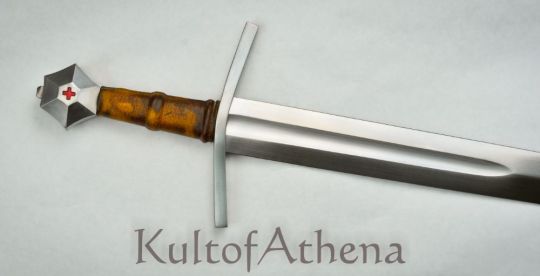
Pre-Owned Arms & Armor – Malaspina Arming Sword
Blade Condition: Moderate cosmetic scuffs and scratches present on blade.
Hilt Condition: Medium amount of Cosmetic blemishing (scuffs, scratches and light shallow pitting) are present, particularly on the pommel.
Grip: Very good condition with only very minor wear
Construction Condition: Sword is still durably peened and solidly constructed
Product Description:
The Arms & Armor Malaspina Sword has a sharpened and tempered blade of 6150 high carbon steel. The crossguard and pommel are steel and the grip is tightly bound with finely stitched and skillfully applied leather. The recessed cross on both sides of the pommel is colored with red enamel.
This sword is heavily inspired by a remarkable sword sculpted onto the funeral effigy of the 14th century Marquis of Fosdinovo: Galeotto Malaspina. Based on the limited visual cues of the effigy, Arms & Armor has opted for a type XVI blade with a short and deep fuller (as seen on many swords of the time). The wide blade of this arming sword is well-suited to making it a very good cutting and slicing blade. The tip can be ably used for thrusting, but the sword clearly has less emphasis on this than later styles, which is quite typical for a sword straddling the transition period from chainmail and partial-plate armors into the greater prevalence of plate armor in the following century.
The pommel is quite complex; nominally hexagonal in profile, it has scalloped surfaces on all its planes which give it a unique and handsome form rarely seen on sword pommels today.
#Kult of Athena#KultOfAthena#Arms and Armor#Arms & Armor#New Item#New Items Wednesday#Pre Owned#Pre-Owned#European Sword#European Swords#Medieval Sword#Medieval Swords#European Weapon#European Weapons#Medieval Weapon#Medieval Weapons#Malaspina Sword#Malaspina#14th Century#Marquis of Fosdinovo#Galeotto Malaspina#Type XVI Blade#Type XVI Sword#Oakeshott Type XVI#Oakeshott
4 notes
·
View notes
Text
A Complete Encyclopedia of the Lore of Every Witcher School
This is a project I've been working on for a long time. The Witcher Schools in general have lore spread across 3 or 4 different sources, so it's very easy to find inaccurate details about each school due to a person only going off of one source without even knowing of the others. Hell, I've been guilty of this in the past. So I've gone out of my way to find every source available for the various Witcher Schools and compile it into one master post, mostly pulling from the standalone Gwent game, and the Witcher TRPG. Without further ado, let's start out with the original school, the Order of Witchers.

Witcher schools are like the Clans of Skellige, subtly different, but largely united by their common ground, and that common ground is the Order of Witchers.
The Order of Witchers began as an experiment by the rogue mages Alzur and his mentor Cosimo Malaspina. They "recruited" tests subjects from orphanages, buying them from neglectful parents, or outright kidnapping street kids.
From Cosimo's Gwent Card:
"Children keep asking him for gifts. He doesn’t know why, but it really helps with finding subjects for his experiments."
The main goal of this project was to create an order of knights artificially mutated and imbued with extreme levels of magic to protect people from a world where, at the time, monsters were often literally around every corner.
The mutation experiments were grueling, and most early candidates died horribly, the girls especially, as the mutagenic compounds the mages were working with at the time were better suited for a boys physiology, and they quickly stopped trying to find a mixture that worked well with women, instead refining the more successful candidate pool. Even with these refinements, however, the Witchers couldn't actually generate much in the way of magical power, at least not nearly as much as those funding the project had hoped for.
These early candidates were encouraged to stick to political neutrality, were told of their duty to protect the common people, and their sword instructor tried to encourage them to take on knightly virtues to live their lives by, though only a few candidates actually bought fully into these particular knightly ideals.
The school developed a training regimen that all later Witcher schools would put their own small twists on. They perfected the whirling sword style, practiced on the Pendulum and Gauntlet training courses. They learned the Witcher Sign magic, created by Cosimo. They were taught hunting and monster lore from experts hired from across the world, and master alchemists crafted the famous Witcher potions.
Ultimately, funding from this school would be pulled due to the Witcher candidates lack of truly powerful magic ability, and the order would start to fracture. Witchers dissatisfied with their lot in life after being forcibly mutated, and railing against the Order's enforced ideals began getting combatative with other Witchers over petty contracts. At this time, contracts were so plentiful that there was no real need to fight over them, but these dissident Witchers did so anyway out of a desire for autonomy and to be free of the Order's code, which they saw as having no practical purpose to prepare new Witchers for the road ahead, and hypocritical as it was forced on them by the mages who never cared for the Witcher's lives. This culminated in one such outspoken Witcher, Arnaghad, attacking another Witcher who poached a contract from him.
After being forced into the painful life of a Witcher, Arnaghad loathed anyone who imposed their will upon him, the Order and it's codes especially. He led an attack on the Order proper, aided by fellow Witchers who respected his defiance towards authority. Once they were beaten back, these dissidents fled to the Amell mountain range to start the next Witcher school, the School of the Bear.
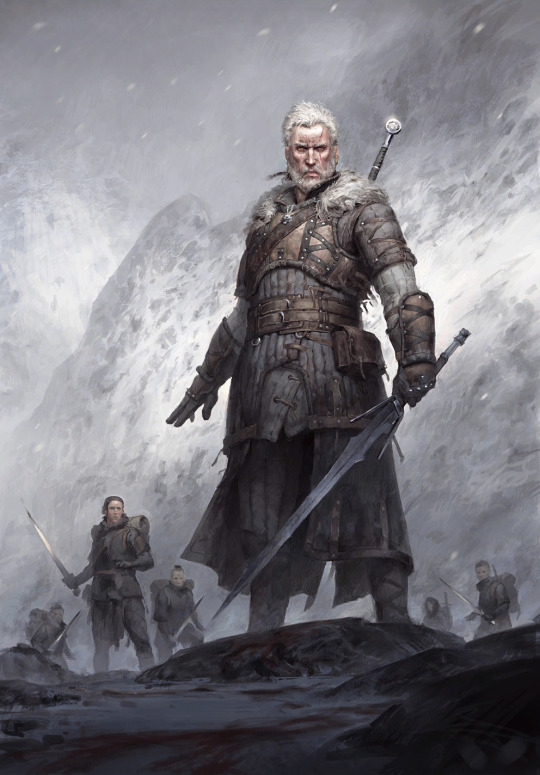
The School of the Bear is one of the most misunderstood schools of them all, owing to the first major lore drop about them being largely in-universe rumors and conjecture surrounding the school, and as such I may need to go more in depth. The two major misconceptions stemming from this is the rumor about their armor, which claims that they don't bother dodging like the other Witchers and instead take blows head on (generally a bad idea, according to Geralt in the books), and the rumor about them attacking most Witchers they meet.
I contacted Cody Pondsmith, who wrote a great deal of this lore, and he mentioned that Bears do often threaten or even fight other Witchers, but in a very Skellige way, only to ward off the other Witcher from contracts they want. The Bears just want to live lives where they aren't commanded by others, and were trained especially brutally, and so will fight for what contracts they want. However they will NEVER kill another Witcher, just draw first blood (outside of duels to decide who runs the school, which occasionally turn deadly. It's unknown if Arnaghad has ever lost these duels) and if that other Witcher stands up to the Bear, they'll let them have the contract and if they meet up and work together enough even maybe become a lifelong friend.
To quote Cody himself: "I like to think of the Witcher Order as a big family in which the Bear School is the blunt, no-nonsense brother. He can be prickly and a bit of a bully sometimes but he takes his job seriously and he can be a good drinking buddy if you get to know him. Not the friendliest of people but far from evil. If you stand up to him and show him you're not afraid of him, he'll respect you."
The other rumor is also an exaggeration. The Witcher TRPG mentions that the Bear armor was designed with flexibility in mind, and while they trained to take on weaker blows with their armor and "mastery of the Quen sign", they also trained how to move quickly in their armor if they needed to dodge a fatal blow. The Bears also still trained on the gauntlet and pendulum like the other schools. Cody Pondsmith also confirmed that the Bears are just as agile as the other Witchers.
The Bears' core philosophy is almost very Lambert like, viewing Witcher's work not as a duty, or knightly virtue, but as difficult, brutal work. The only reason they stick to this work is to do a job where no one else commands them and they're left in peace. They focus only on the practical aspects of their profession, and as such discourage their students from working together in training, since Witchers work alone. As Arnaghad said, "We pass through life alone, better get used to it!" As a result, Bears are very isolated, preferring their own company to that of other Witchers, and were encouraged to value their autonomy and self care above all else. The Bears' final trial involved climbing to the top of Mt. Gorgon and back, and any who died from the cold were left "as a sobering reminder of the dangers of their trade". Despite this, the TRPG has a list of random early training events Witchers from all schools can have, and Bears could sometimes make friends amongst their fellow witchers in training just like members of every other school.
Once the new Bear students left their keep of Haern Caduch, most wouldn't return to winter there, unlike the other schools. They developed a reputation as being terrible to fight, and for being firebrands, often speaking very bluntly, not matter who they spoke to, authority included. Once such Witcher, named Gerd, was asked by a Duchess to help kill her father. He insulted her so badly he got a warrant for his death placed on him, though all the peasants he met spoke rather highly of him. As a result, Bears found it easiest to make friends amongst the similarly minded Dwarves and Gnomes of the Amell mountains, and people of the Skellige Isles. According to Cody Pondsmith, this is the main reason the Bears stayed together as a group at all. They valued autonomy above all else and so long as they functioned as a Witcher school, they were left alone and no rulers would try and command them. They also take their ideals of free will and apply it to others, never seeking to rule over others. They simply wish to live their lives free.
One of the original Witchers to side with Arnaghad, Ivar Evil-Eye, had extra mutations done to him by the Order of Witchers during his trial, allowing him to see into other worlds. In these visions he saw the Wild Hunt rampaging across them, conquering them. Ivar became obsessed with stopping them, and tried to kill Arnaghad to take command and lead the Bear school against the Hunt. This failed, so he and his supporters left to form the Viper School.
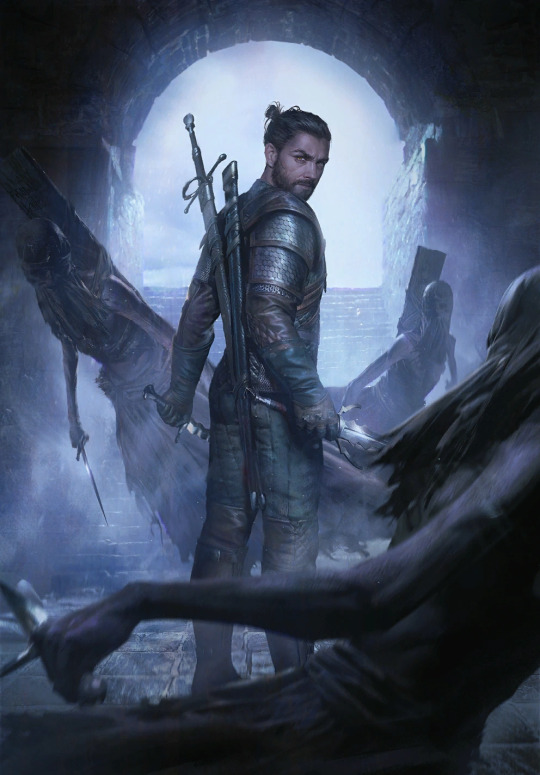
The Witchers of the Viper school, based in Gorthur Gvaed, were said to be the most secretive, taking contracts as both assassins and witchers. They at first dedicated themselves finding a way to stop the Wild Hunt, amassing a massive library on the subject. Fighting with an unpredictable, ambushed based variant of the Witcher fighting style, Viper Witchers employed poisons, brewed by skilled Viper alchemists, on both their swords, and a dagger in their offhand, their biggest deviation from typical Witcher combat techniques.
Vipers, for an unknown reason, eventually forgot their purpose. In his time, Letho of Gullet could only guess at why the school had been founded. Instead, they became famous for their skill at political killings, dealing with the nobility of the southern countries before Nilfgaard had even become a large-scale power.
Viper students had a different type of trial, after more grueling than typical training. Instead of any physical task like the other schools, the Viper students were given a pet at their induction to the school. And to graduate, they simply had to hunt it down and kill it, showing their lack of mercy.
While most of those who supported Ivar followed him to the Viper school, one group broke off and west east, across the Korath desert, to Zerikania, founding the School of the Manticore.

The School of the Manticore was founded by the Witcher Iwan, from the School of the Bear, following Ivar's assassination attempt on Arnaghad. They got work in the Korath desert as caravan guards, earning the attention of the Zerrikanian Queen after a deadly battle with a manticore. The Queen sponsored the Witchers of the Manticore, making them the only school to be officially backed by any government. They were experts on potions and anti-toxins, a necessity of dealing with the poisonous creatures of the Korath desert.
A unique adaptation to the monsters of the desert also had Manticore Witchers employ shields into the whirling combat of their Witcher training. Given their extra support, the Manticores held two keeps, Behelt Nar and Bailsuf Alsarea, on opposite sides of the desert, so that they might better patrol and guard those within it.
The Manticore is the final school to come from the schism Arnaghad had led. The other voices of dissent against the ideals of the Order would soon hear of these new schools and decide to break off as well to form the School of the Cat.

The School of the Cat was founded out of a response to the hatred and distrust Witchers received. They desired to be seen in a better, more respectful light. Ironically, they would end up doing the opposite. The Cat School stole away with several of the mutagens needed to make more Witchers and headed to Ebbing, and Stygga Citadel, where they would begin to experiment on human-elf children in an attempt to perfect the mutations. Its possible that the mages at this time furthered experiments on making women Witchers, but this is not confirmed yet.
Attempting to make a name for themselves, the Cats hired themselves out as spies, assassins, and mercenaries, genuinely earning them some respect from common folk for killing bandits.
In their attempts to perfect the mutations and further dull the emotions of their Witchers, the Cat school experimented harshly on a group of children that resulted in the opposite, giving these Witchers hightened emotional responses instead. These students, cast aside and left for dead, fled into the arms of a group of elves, who agreed to support them if this branch of the Cat School supported the elves' fight for freedom.
This branch, led by Gezras of Leyda, attached itself to the Dyn Marv caravan and traveled the continent, lending their services mostly to those nonhumans who could pay, while the main Cats at Stygga ended up getting assaulted by angry royals incited by their political maneuvering. This left the Dyn Marv branch as the only functional element of the School of the Cat. These Cats would train students' agility in a light, fast Elven take on Witcher fighting style, and would train their balance by making students walk a tightrope, starting low to the ground at first, but getting higher and higher each attempt.
The Cat school's breaking of Witcher neutrality and reputation for bloodlust earned Witchers such a bad name that those in the Order who most cherished their old swordmaster's knightly virtues would leave to form the School of the Griffin.

The School of the Griffin, led by Erland of Larvik, wished to truly achieve the dream of the original Order, and Gryphon, the Order's sword instructor. They traveled north to Kaer y Saren, an old fortress the Order once used, and cleansed it of the spirits of those who died in the first Witcher mutations. From there, they began a Witcher school focused on respectability and honor, believing in their knightly duties. And it worked, somewhat. The Griffins were sometimes advisors to nobility, and seen as honorable, but the prejudice against Witchers would never leave, and most would never see a Griffin Witcher as anything more than a monster playing at being a knight.
These Witchers tried their best to cushion their students against the pain of their lives on the Witcher's path, and were more brotherly than the other schools, though their knightly virtues and brotherhood were oftentimes cold comfort to Griffin students.
From the Witcher TRPG Sourcebook:
"Witcher I knew couldn’t really remember much ‘bout his past. Heh, too young to really form a lotta memories when they took him to Kaer Y Seren. Told me that the memory he did have made the mutations easier. Poor bastard clung to a memory of his pa takin’ him on a horse for a ride in the fields. Don’t know why he chose that one. Probably the only normal memory he had."
The Griffins amassed a huge library of magical knowledge, though they could only push sign magic so far, and the books were likely wasted being in a Witcher library. The library held several incredibly famous tomes on magic within, and was the envy of full mages across the Northern Realms. Despite all their efforts, they never could achieve their goal of bringing about the Order of Witcher's vision. The Griffins even had their own breaches of Witcher tradition in pursuit of their knightly heroics. An often said mantra of the Griffin school in Gwent is "To slay dragons! Tis our knightly duty!" despite dragons being largely innocent, intelligent beings who mostly wish to be left in peace.
Code Pondsmith had this to say about the Griffins:
"The Griffins stuck to the knightly traditions that the original witcher order tried to uphold. As a result it's safe to say that the Griffin school taught that monsters were the enemy of mankind and must be defeated. I don't think they would all be blindly overzealous but they wouldn't have any qualms about slaying sapient monsters if they believed it was for the good of mankind. Similarly, it's likely that they would side with humans in any conflict between monsters and humans. In a way, the Griffins' knightly virtues made them easier to manipulate than the other witcher schools. They were bound to protect humanity and thus were more likely to be convinced to hunt a monster if a local noble or alderman claimed it would be for the good of the people. This is the case with the dragons. The kingdoms and jewelers guilds of the North convinced the Griffin School that dragons were a blight upon humanity and the Griffins started slaying dragons regardless of whether all of the dragons they slew deserved it. Additionally, the knightly values might make Griffin school witchers more likely to take pity on desperate humans and work for free."
Those few Witchers remaining in the Order by now traveled to northern Kaedwyn, and started a school based on their tempered, traditionalist, and realistic view on the Order's goals. They based themselves in Kaer Morhen and dubbed themselves the School of the Wolf.
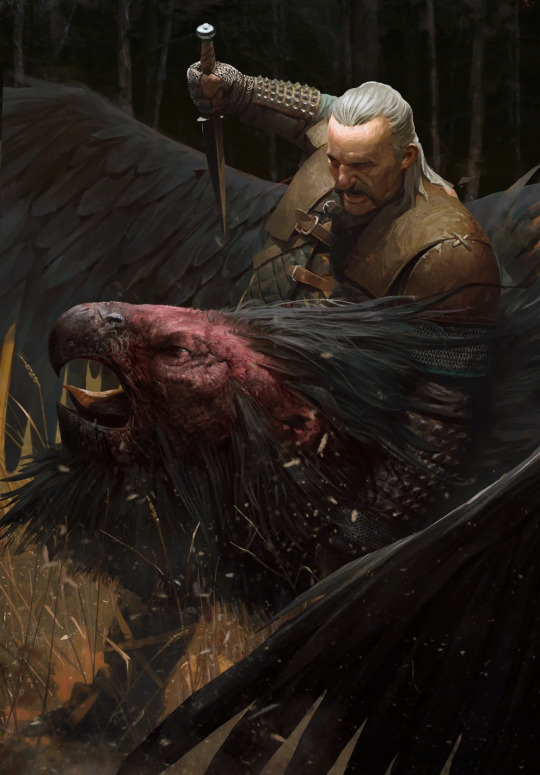
The School of the Wolf is the most famous Witcher school, known for their professionalism and efficiency. They don't kill humans like the Viper or Cat. Aren't bold or brash like the Bear, or put Knightly virtues above Witcher ideals like the Griffin. I mean, anyone reading far this knows who the Wolf Witchers are, so I'm not going to get into to much detail. They're Geralt's school. Ciri's school.
They took a balanced approached to Witcher life and as such trained Witchers who were the best adjusted out of the schools, with neither the Bear's harshness nor the Griffin's egocentrism. For this, Wolf Witchers were lauded all across the Continent.
With all Schools formed, the Golden Age of Witchers began, at first with the Bears and Griffins making peace. From Erland of Larvik's Journal (The TRPG's monster manual):
"Surprisingly enough the fracturing of the witcher order had lead to a more effective organization for us witchers. Spread across the Continent and each making more witchers independently, it was no longer the task of 60 or 70 witchers to patrol the entire Continent from Nilfgaard to Kovir. Each school patrolled their own path and when a Gryphon met with a Bear each knew they had their territory and any infighting wouldn’t be worth the bloodshed. We managed to broker peace and live as somewhat estranged brothers rather than bitter enemies"
Witchers at this time were seen largely as heroes, with their detractors' voices largely simmering underneath. With Witchers around to kill monsters, people felt safe and so ignored any misgivings they might have.
Witchers, no matter the school, aren't too dissimilar from each other, and so the Cintinent at large formed an overall opinion of the Witchers based on the traits they all shared. From the TRPG:
"In the heyday of witchers there were many many seperate schools, which all mutated new witchers and taught them the neccesary skills to hunt monsters and lift curses. While it’s generally agreed that there is a core set of skills required to a be a witcher,
each school taught its students differently and focused on different aspects of witcher training. Thus, witchers from different schools often act differently and go about their jobs in similar but varied ways."
During this time, the Schools all produced hundreds of Witchers, and each was their own person, With their own preferences and personality, despite the schools themselves having reputations for Witchers with only a few certain traits. For instance, the Bear Witcher Ivo of Belhaven fought like a Viper or Cat Witcher, but in personality was a perfect fit for the Bear School with how standoffish he could be.
They also all customized their gear in different ways, usually keeping their gear in similar fashion to their school's, as its what they trained in an were used to. For example, Bear Witcher Junod of Belhaven wore what appears to be a set of Wolf School armor he had modified to fit Bear Witcher style.
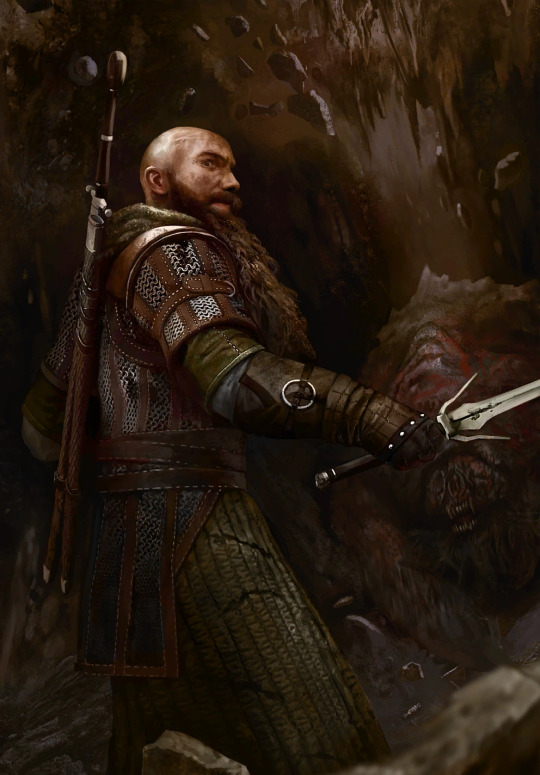
Witchers also at this time experimented with signs. The Griffins obviously focused on making them more powerful, and the Bears pushed Quen to a level beyond any other school. But the most interesting case is that of Warrit, a blind Viper Witcher who used the lesser known Somne sign as a form of echolocation.

The Golden age lasted for around 150-200 years or so, ending around 1160 when the monster populations had been hunted down enough that people's main concern stopped being the monsters, and became the Witchers themselves.
The Griffin School, refusing to share the knowledge of its library, was destroyed by jealous mages. A group of peasants and mages attacked the Wolves' keep out of nowhere. The Bears failed to destroy a powerful cabal of vampires and, when peasants rioted and came for their keep, chose to disband rather than engage in needless slaughter. The Cat's keep of Stygga is destroyed, but the Dyn Marv chapter may still be alive and well. The Manticore School failed to protect an important prince from a fire elemental, and so lost their funding and closed. The Viper refused to support the Nilfgaardian usurper and were destroyed.
If you've made it this far, holy shit, thank you! I hope you have a great day!
#the witcher#Witcher schools#Witcher lore#as if anyone needed more proof I am a huge nerd#I hope this genuinely does help people though#School of the Cat#School of the Bear#School of the Wolf#School of the Griffin#School of the Viper#School of the Manticore#Wrote this because I have writer's block for my fic#geralt of rivia#lambert#eskel#vesemir#Ciri#arnaghad#Erland of Larvik#Ivar Evil-eye#Iwan#Gezras of Leyda#Witcher Role Playing Game#Witcher TRPG
95 notes
·
View notes
Photo
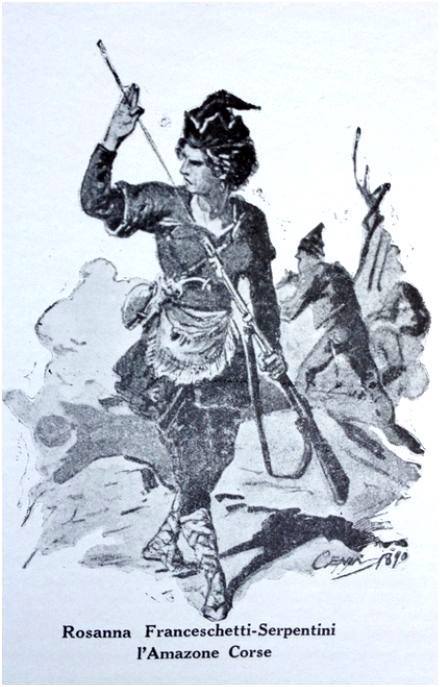
Rosanna Franceschetti-Serpentini and other Corsican heroines
In 1729, the island of Corsica was under the rule of the republic of Genoa, Italy. The local people rose against their overlords, which led to a conflict that lasted forty years before being fully resolved.
Many women distinguished themselves during this struggle. One of them was the daughter of the rebel leader Fabio Vinciguerra. Described as being of a warlike disposition, she swore revenge when her father was assassinated by the governor. Taking the head of his troops, she was known for the brutality with which she fought the Genoese soldiers. In 1739, the wife of Bartolo of Barbaggio acquired similar fame for her courage in battle.
In 1746, Faustina Gaffory, defended her home in Corte from the Genoese with a handful of companions. Seeing their energies falter, she showed her comrades a powder barrel and threatened to blow-up the house. The defenders thus kept fighting.
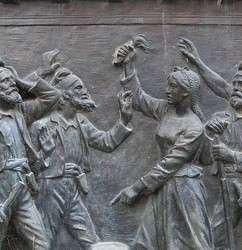
In 1761, the women of Tenco defended their town. One of them, Josephine Jacobi armed herself and joined the fray. Other women imitated her and fought. Animated by their example, the defenders repelled the besiegers.
Several women fought at the battle of Borgo in 1769 on the side of the Corsican patriot and military leader Pasquale Paoli. Magistrate and memorialist Salvatore Viale described them as armed with rifle and knife, sharing the perils of war with their husbands.
Among them was Rosanna Franschetti-Serpentini who fought alongside her husband, an officer. She was dressed in male attire and “always well armed”. She was nicknamed “the heroine” or “our captain”. Rosanna notably defeated a French officer in hand-to-hand combat (since French troops had landed in Corsica after Genoa sold the island to France). When she saw that her side had to retreat, she freed her captive and said: “Remember that a Corsican woman overcame you and gave you back your sword and freedom”.
Bibliography:
Aimé André, Histoire générale de la Corse depuis les premiers temps jusqu'a nos jours, vol.2
Albertini Jean-André, Orsatelli Andrée, Corté et la renaissance de l'université corse
Bessières Luc, Panthéon des martyrs de la liberté, ou histoire des révolutions politiques, et des personnages qui se sont dévoués pour le bien et la liberté des nations, etc.
Ettori Fernand, Mémorial des corses
Fillipi Antoine-Baptiste, La corse, terre de droit: Essai sur le libéralisme latin et la révolution philosophique corse (1729-1804)
Gio Pietro Vieusseux, Archivio storico italiano: ossia raccolta di opere e documenti finora inediti o divenuti rarissimi riguardanti la storia d'Italia, vol.14
Gregorovius Ferdinand, Corsica in Its Picturesque, Social, and Historical Aspects: The Record of a Tour in the Summer of 1852
Pomponi Francis, Émeutes populaires en Corse : aux origines de l'insurrection contre la domination génoise (Décembre 1729 - Juillet 1731)
Renucci Francesco Ottaviano, Quattro storiche novelle
Malaspina Toussaint M., “La Corse”, Revue politique et littéraire: revue bleue
#history#women in history#Faustina Gaffory#Josephine Jacobi#Rosanna Franschetti-Serpentini#corsica#Corsican history#18th century#warrior women#france#french history
80 notes
·
View notes
Text
Witcher Character Ages Pt. 1
The Preface
Since I have decided to make head canons for “the witcher” I have come forward to bring order into the chaos. So here we are. With me once again writing something I’ve already written in a discord. Buckle up people, this is gonna be a lot. Also Spoilers, duh
To make things very clear: many things I’ll write in this posts are not my work. In fact it’s mostly taken from the following posts
http://www.sapkowski.su/modules.php?name=Articles&pa=showarticle&artid=112#21
https://dtf.ru/flood/30575-vozrast-glavnyh-personazhey-vselennoy-vedmaka
https://witcher.fandom.com/wiki/Timeline
Now the keen eyed reader might notice that two of these links lead to sites that are written in Russian, to which I would say: “You are right. They totally are.”
Now moving on quickly, I will present you with some reference points for the general timeline:
The book-saga: Geralt’s story ends in June 1268, the Assault on Stygga Castle most likely happens in March
The Witcher: May - September 1270
The Witcher 2: Assassins of Kings: April - November 1271
The Witcher 3: Wild Hunt: May - ? 1272
The Witcher: Of Flesh and Flame: 1273 but it’s a comic so I’ll promptly ignore it
Blood and Wine DLC: 1275
Furthermore and it might not even be relevant but I think it is so I’m including it, there is an interesting document one can find in Wither 3 in Kaer Morhen about the Trial of Grasses. This document suggests the age range for this trial (8-10 years) and considering. Both Russian sites I have linked have made the connection that The Witcher mostly resembles the real world High Middle Ages, which in order suggests the age of maturity being 21 (it’s not mentioned in the English wiki tho, that’s why there is the German link).
So. Now that we got the out of the way let’s get to our first subject:
Vesemir
We have ... literally no idea, BUTT! the timeline I included states he was active during 1112, so he has to be very much older. Apparently he has been around for the construction of Kaer Morhen as well.
The first witchers were put on recorded in the 960s, though the wiki timeline states the 950s (probably a typo). They were created by the two mages Cosimo Malaspina and Alzur (who probaly did most of the work). Kaer Morhen was constructed at the end of the X century, so perhaps Pappy Vesemir was one of the first witchers. Which would mean he would have to been born 939 (earliest). Which would in make him 333 years old during the events of the Wild Hunt.
Ciri and Timelines
Okay let’s get this out of the way now. Most of the short story timelines have been (as far as I can see) calculated with Ciri’s age.
As explained in the first link, in the last book Emhyr and Geralt meet for a second time, the first being during the feast in Cintra (A Question of Price). Here Emhyr states the have seen each other 16 years ago (I am paraphrasing). Ergo: “A Question of Price” happened in 1252.
Ciri was born during Belleteyn, which is celebrated April 30th to May 1st, so it is safe to assume she was born in 1253.
Ciri was brought to Kaer Morhen in autum of 1263 and it’s safe to assume he brought her to the keep as soon as he found her in “Something More”. That means the first war with Niflgaard happened in either 1262 or 1263. The fall of Cintra happened then as well. Not too long before that Geralt met Ciri for the first time in “Sword of Destiny”. 1262.
Also I need to mention one other thing: the game does state Ciri’s year as both 1251 and 1253, but I’m sure we can all agree CDPR made a mistake. Ciri is 19 in W3.
Geralt (and Eskel)
Since Geralt and Eskel are said to be the same age Imma just throw them together, which means figuring out Geralt’s age is key here.
Though the games state him to be almost a century old, it’s rather unlikely in my humble opinion. CDPR might have just assumed that because of Yennefers age (which I’ll get to eventually). However, the books mention another character we can use as reference for Geralt’s age: Nenneke.
In the books Nenneke is described as T H I C C and smol, but never really as old. She’s also rather graceful and quick. Nenneke mentions she raised Geralt, from a young age and mentions his height being around her waist back then. Perhaps Geralt was around 5 years old. The short story in which we can read so much about Nenneke (”The voice of Reason”) apparently happens not too long after Geralt invoked the “Law of Surprise” in Cintra, so maybe around 1253. If we assume Nenneke is in her 50s in that story, and she is probably at least 15 years older than Geralt - that way she would have been 20 when she began to raise him - Geralt’s year of birth can be ranged between 1210 and 1220, to which the article just said “Meh, let’s meet in the middle”. Geralt was born in 1215, which makes him 57 years old. Which means Eskel is 57 years old as well.
From that we can also date the short story “A Grain of Truth”, which is probably one of his first adventures judging by how unprofessional he behaves at times; he talks to Roach (which is a thing that never really happens in the books outside of that story), takes ages to figure out that he’s dealing with a Bruxa, oh and he fucking yells at her. Probably 1235ish.
“The Lesser Evil” also probably happened quite early in his career, so maybe around 1240ish.
Dandelion
Or Jaskier, whichever you like better. His birth year was actually given as 1229, which makes him 43 during the events of the Wild Hunt. Also the second article I linked in the beginning mentions he started singing in 1248, aged 18-19. “The Last Wish” is estimated to have happened in 1250. By that time Dandelion and Geralt have already been friends. “The Edge of the World” chronologically happens before that, so maybe in either 1248 or 1249.
And Yennefer
Yennefer actually states her age in “Tower of Swallow” (1267). She’s 94 in that book, so she’s 99 years old in the third game. She was born during Belleteyn in 1173. In 1250, during the Last Wish she and Geralt were 77 and 35 respectively. Shortly afterwards they broke up, meeting each other four years later in “Bounds of Reason” and probably broke up once again during the events of “A Shard of Ice”. Both of these stories happen in 1254.
On that note, both “The eternal Flame” or how a Witcher befriended a Doppler and “A Little Sacrifice” or relationships suck without compromises also happen in 1254.
**********
Well that’s it for today, Kids. I don’t know when I’ll do Pt. 2, but it’ll probably include Geralt’s Hanse, Lambert, Triss and maybe Emhyr too.
Also, this is literally me rn

Also, I swear Part 2 is going to be less of a mess
#the witcher#the witcher timelines#witcher headcanon#witcher canon#vesemir#witcher geralt#geralt of rivia#cirilla fiona elen riannon#yennefer of vengerberg#yennefer#jaskier#the witcher dandelion#eskel#witcher eskel#omg this took me hours#i can't even#this is a mess#pls send help#the russian side of the internet is a treasuretrove#part 1
10 notes
·
View notes